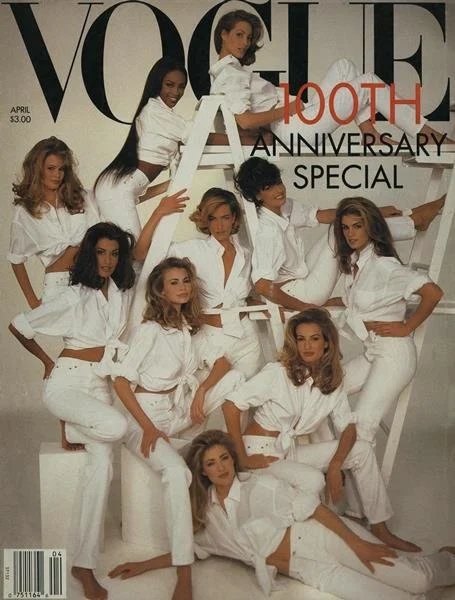The Evolution of the Supermodel, From Bettina to Bella
What comes to mind when you think of the word “supermodel”? Maybe you picture the Big Six, the figureheads of the supermodel craze of the ’90s. Or maybe you see the social media mavens of the current decade, juggling online followings with runway bookings. But what exactly is it that elevates a model to “super” status?
The idea of the supermodel has undergone a major metamorphosis over the past few centuries. Modeling as a profession began in the mid-1800s, when English designer Charles Frederick Worth asked live models to showcase his pieces. For nearly a century, models remained underpaid and unnamed, receiving very little recognition for their work. At the time, the notion of a “supermodel” was entirely unrealistic. But as technology advanced, models got more and more opportunities to step into the limelight, popularizing the profession and eventually including to the coveted “super” status as a way to honor the industry’s most influential players. But with the public’s ideas of fame growing increasingly complex, how do we define a “supermodel” in 2022? Looking back on the industry’s greats can provide some answers.
Initially, photographers were the main controllers of model demand — they requested which models they wanted to work with, and models gained notoriety from their association with a well-known photographer. Swedish model Lisa Fonssagrives, who is widely regarded as the first supermodel, rose to prominence in 1936 after taking test shots with Vogue photographer Horst P. Horst. Her fame quickly increased, and shortly after her move to the United States in 1939, she appeared on newsstands covering 11 Vogue issues.
In the mid-’40s, two other models began their rise to supermodel status. Simone Micheline Bodin, who went by the professional moniker Bettina, dominated the fashion scene in France, becoming a muse to Hubert de Givenchy. In the United Kingdom, Barbara Goalen gained recognition not only from photographers, but from the general public –– her 1954 wedding (which also marked her retirement) was swarmed with fans.
By the ’60s, modeling was no longer just an artistic relationship between a photographer or designer and their muse. Models were tapping into the business opportunities of the industry, signing highly lucrative contracts and marketing their names and likenesses as brands in and of themselves. After being named the “Face of ’66” by the Daily Express, British model Twiggy launched her own range of tights in 1969, aptly named Twiggy Tights. The same year, Lauren Hutton signed an exclusive contract with Revlon, becoming the first model to act as the face of a brand. Brand exclusives became the mark of a supermodel well into the ’70s. Margaux Hemingway signed a $1 million contract to become the face of Babe Perfume in 1975. Christie Brinkley became the face of Covergirl in 1976, a role she would hold for the next 20 years.
Over the next two decades, supermodels’ celebrity status reached a new high. Naomi Campbell, Christy Turlington and Linda Evangelista were known as “The Trinity,” with the three women ruling runways around the world and raking in record amounts of money in the process. Evangelista infamously joked in the October 1990 issue of Vogue that “we don’t wake up for less than $10,000 a day.” The Trinity then became the “Big Six,” when Cindy Crawford, Claudia Schiffer and Kate Moss rose through the ranks in the ’90s. The end of that decade and the early 2000s saw modeling get even more mainstream: the first Victoria’s Secret Angels were granted their wings in 1997, and the first episode of Tyra Banks’ “America’s Next Top Model” aired in 2003.
Vogue’s April 1992 100th anniversary cover featuring 10 of the biggest supermodels of the year, including Campbell, Crawford, Evangelista, Schiffer and Turlington – photo by Patrick Demarchelier
But in the 2010s, the concept of the supermodel crumbled before our very eyes. Being discovered by a scout or signed to an agency was no longer the only major path to fashion stardom. Social media offered aspiring models a new way to gain popularity and gave established models a platform of unprecedented size. Sponsored posts changed the way models act as the face of a brand or product. Whereas the primary qualifications for a 20th-century supermodel were magazine covers and exclusive contracts, now a model’s popularity can be easily measured by their follower count or number of likes.
But even with the clearer metrics that social media provides, many argue about who is a true supermodel in 2022. Kendall Jenner topped Forbes’ list of the highest paid models in 2018, and she currently has over 235 million Instagram followers. But despite these numbers, some don’t recognize Jenner as a supermodel because of how few shows she walks each year. Jenner was quoted by Love Magazine saying she “was never one of those girls who would do like 30 shows a season,” a statement that angered many working models at the time. Nepotism is also a common criticism of Jenner and many other current supermodel contenders, like Gigi and Bella Hadid and Cara Delevingne, whose rise to fame coincided with their rise in Instagram followers.
The Hadids, Jenner and Hailey Bieber at the 2015 Met Gala – photo by Michael Stewart
It’s much harder to identify the “supers” of today. The job itself is significantly more complex than it was at its start; models in 2022 have to juggle runway and commercial jobs, public appearances, endorsements and brand deals, all while engaging an online audience. The expansion of what being a model entails makes the job more difficult than it was at the beginning, even today's lesser-known models would be a "supermodel" by the original standards. The modeling industry has come a long way, surpassing any expectation of the profession at its inception. That alone seems pretty super to me.



